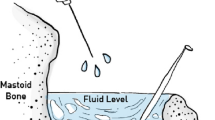Abstract
Purpose
Complete removal of the matrix over the existing fistula in the event of an extensive cholesteatoma with labyrinth invasion can result in total deafness. This study aimed to present a novel method of underwater endoscopic labyrinth dissection using continuous steroid irrigation (CSI) and systemic steroid administration for hearing preservation.
Methods
The endoscopic diving technique (EDT) was used to dissect semicircular canals, revealing the underwater anatomy of membranous labyrinth structures, in two cadaver temporal bones. EDT with CSI was used in three clinical cases with extensive cholesteatoma.
Results
On cadaver temporal bones, the anatomy of the lateral (LSC), superior (SSC), and posterior membranous semicircular canals with their respective ampullas and common crus was documented. In the first case managed with transcanal EDT, the LSC was eroded across almost its entire length. The fallopian canal was circumferentially eroded at the second genu and part of the mastoid segment. The cholesteatoma matrix was completely removed, and the membranous LSC was preserved. In the second and third cases, we were able to remove the cholesteatoma matrix along the eroded bony semicircular canals while keeping the membranes intact. No sensorineural hearing loss was detected in the postoperative masked pure-tone audiometry at a mean follow-up time of 12 months or cholesteatoma recurrence at the follow-up imaging.
Conclusions
EDT with CSI can be safely utilized in the course of temporal bone labyrinth dissections and provides advantages during cholesteatoma removal over the eroded labyrinth on preservation of the membranous structures, and thus may help preserve cochlear function.





Similar content being viewed by others
References
Jang CH, Jo SY, Cho YB (2013) Matrix removal of labyrinthine fistulae by non-suction technique with intraoperative dexamethasone injection. Acta Otolaryngol 133(9):910–915. https://doi.org/10.3109/00016489.2013.782105
Stephenson M-F, Saliba I (2011) Prognostic indicators of hearing after complete resection of cholesteatoma causing a labyrinthine fistula. Eur Arch Otorhinolaryngol 268(12):1705–1711. https://doi.org/10.1007/s00405-011-1545-7
Gocea A, Martinez-Vidal B, Panuschka C, Epprecht P, Caballero M, Bernal-Sprekelsen M (2012) Preserving bone conduction in patients with labyrinthine fistula. Eur Arch Otorhinolaryngol 269(4):1085–1090. https://doi.org/10.1007/s00405-011-1757-x
Ikeda R, Nakaya K, Oshima H, Oshima T, Kawase T, Kobayashi T (2011) Effect of aspiration of perilymph during stapes surgery on the endocochlear potential of guinea pig. Otolaryngol Head Neck Surg 145(5):801–805. https://doi.org/10.1177/0194599811409516
Prasad SC, Shin S-H, Russo A, Di Trapani G, Sanna M (2013) Current trends in the management of the complications of chronic otitis media with cholesteatoma. Curr Opin Otolaryngol Head Neck Surg 21(5):446–454. https://doi.org/10.1097/moo.0b013e3283646467
Palva T, Kärjä J, Palva A (1971) Opening of the labyrinth during chronic ear surgery. Arch Otolaryngol 93(1):75–78. https://doi.org/10.1001/archotol.1971.00770060107014
Geerse S, de Wolf M, Ebbens F, van Spronsen E (2017) Management of labyrinthine fistula: hearing preservation versus prevention of residual disease. Eur Arch Otorhinolaryngol 274(10):3605–3612. https://doi.org/10.1007/s00405-017-4697-2
Dornhoffer JL, Milewski C (1995) Management of the open labyrinth. Otolaryngol Head Neck Surg 112(3):410–414. https://doi.org/10.1016/s0194-5998(95)70275-x
Yamauchi D, Honkura Y, Kawamura Y, Shimizu Y, Sunose T, Hara Y, Ohta J, Suzuki J, Kawase T, Katori Y (2021) Underwater endoscopic ear surgery for closure of cholesteatomatous labyrinthine fistula with preservation of auditory function. Otol Neurotol 42(10):e1669–e1676. https://doi.org/10.1097/mao.0000000000003241
Locatelli D, Canevari FR, Acchiardi I, Castelnuovo P (2010) The endoscopic diving technique in pituitary and cranial base surgery. Neurosurgery 66(2):E400–E401. https://doi.org/10.1227/01.neu.0000363746.84763.a5
Yamauchi D, Yamazaki M, Ohta J, Kadowaki S, Nomura K, Hidaka H, Oshima T, Kawase T, Katori Y (2014) Closure technique for labyrinthine fistula by “underwater” endoscopic ear surgery. Laryngoscope 124(11):2616–2618. https://doi.org/10.1002/lary.24785
Thangavelu K, Weiß R, Mueller-Mazzotta J, Schulze M, Stuck B, Reimann K (2021) Post-operative hearing among patients with labyrinthine fistula as a complication of cholesteatoma using “under water technique.” Eur Arch Otorhinolaryngol. https://doi.org/10.1007/s00405-021-07058-z
Cömert E, Cömert A, Tunçel Ü, Tekdemir I (2014) Surgical anatomy of facial nerve for revision transmastoid surgery. J Craniofac Surg 25(2):619–622. https://doi.org/10.1097/scs.0000000000000499
Trune DR, Canlon B (2012) Corticosteroid therapy for hearing and balance disorders. Anat Rec (Hoboken) 295(11):1928–1943. https://doi.org/10.1002/ar.22576
Ye Q, Tillein J, Hartmann R, Gstoettner W, Kiefer J (2007) Application of a corticosteroid (Triamcinolon) protects inner ear function after surgical intervention. Ear Hear 28(3):361–369. https://doi.org/10.1097/01.aud.0000261655.30652.62
Plontke S, Götze G, Rahne T, Liebau A (2017) Intracochlear drug delivery in combination with cochlear implants. HNO 65(1):19–28. https://doi.org/10.1007/s00106-016-0285-9
Anagiotos A, Beutner D, Gostian A-O, Schwarz D, Luers J-C, Hüttenbrink K-B (2016) Insertion of cochlear implant electrode array using the underwater technique for preserving residual hearing. Otol Neurotol 37(4):339–344. https://doi.org/10.1097/mao.0000000000000989
Schmerber S, Baguant A, Fabre C, Quatre R (2021) Surgical treatment of cholesteatomatous labyrinthine fistula by hydrodissection. Eur Ann Otorhinolaryngol Head Neck Dis 138(4):279–282. https://doi.org/10.1016/j.anorl.2020.11.004
Acknowledgements
This study was presented in part at the European Academy of Otology Neurotology 2021 Virtual Meeting (Sept. 6–9, 2021).
Funding
None.
Author information
Authors and Affiliations
Corresponding author
Ethics declarations
Conflict of interest
None.
Ethical approval
The authors assert that all procedures contributing to this work comply with the ethical standards of the Declaration of Helsinki. Informed consent was obtained from all participants.
Additional information
Publisher's Note
Springer Nature remains neutral with regard to jurisdictional claims in published maps and institutional affiliations.
Supplementary Information
Below is the link to the electronic supplementary material.
Online Resource 1. Surgical video, preoperative and postoperative details, and results of the endoscopic diving technique with continuous steroid irrigation in case 1
Rights and permissions
Springer Nature or its licensor holds exclusive rights to this article under a publishing agreement with the author(s) or other rightsholder(s); author self-archiving of the accepted manuscript version of this article is solely governed by the terms of such publishing agreement and applicable law.
About this article
Cite this article
Mulazimoglu, S., Meco, C. Endoscopic diving technique for hearing preservation in managing labyrinth-invading cholesteatomas. Eur Arch Otorhinolaryngol 280, 1639–1646 (2023). https://doi.org/10.1007/s00405-022-07635-w
Received:
Accepted:
Published:
Issue Date:
DOI: https://doi.org/10.1007/s00405-022-07635-w




